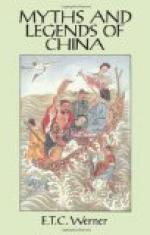Pending the discovery of decisive evidence, the following provisional conclusion has much to recommend it—namely, that the ancestors of the Chinese people came from the west, from Akkadia or Elam, or from Khotan, or (more probably) from Akkadia or Elam via Khotan, as one nomad or pastoral tribe or group of nomad or pastoral tribes, or as successive waves of immigrants, reached what is now China Proper at its north-west corner, settled round the elbow of the Yellow River, spread north-eastward, eastward, and southward, conquering, absorbing, or pushing before them the aborigines into what is now South and South-west China. These aboriginal races, who represent a wave or waves of neolithic immigrants from Western Asia earlier than the relatively high-headed immigrants into North China (who arrived about the twenty-fifth or twenty-fourth century B.C.), and who have left so deep an impress on the Japanese, mixed and intermarried with the Chinese in the south, eventually producing the pronounced differences, in physical, mental, and emotional traits, in sentiments, ideas, languages, processes, and products, from the Northern Chinese which are so conspicuous at the present day.
Inorganic Environment
At the beginning of their known history the country occupied by the Chinese was the comparatively small region above mentioned. It was then a tract of an irregular oblong shape, lying between latitude 34 deg. and 40 deg. N. and longitude 107 deg. and 114 deg. E. This territory round the elbow of the Yellow River had an area of about 50,000 square miles, and was gradually extended to the sea-coast on the north-east as far as longitude 119 deg., when its area was about doubled. It had a population of perhaps a million, increasing with the expansion to two millions. This may be called infant China. Its period (the Feudal Period) was in the two thousand years between the twenty-fourth and third centuries B.C. During the first centuries of the Monarchical Period, which lasted from 221 B.C. to A.D. 1912, it had expanded to the south to such an extent that it included all of the Eighteen Provinces constituting what is known as China Proper of modern times, with the exception of a portion of the west of Kansu and the greater portions of Ssuch’uan and Yuennan. At the time of the Manchu conquest at the beginning of the seventeenth century A.D. it embraced all the territory lying between latitude 18 deg. and 40 deg. N. and longitude 98 deg. and 122 deg. E. (the Eighteen Provinces or China Proper), with the addition of the vast outlying territories of Manchuria, Mongolia, Ili, Koko-nor, Tibet, and Corea, with suzerainty over Burma and Annam—an area of more than 5,000,000 square miles, including the 2,000,000 square miles covered by the Eighteen Provinces. Generally, this territory is mountainous in the west, sloping gradually down toward the sea on the east. It contains three chief ranges of mountains and large alluvial plains in the north, east, and south. Three great and about thirty large rivers intersect the country, their numerous tributaries reaching every part of it.




